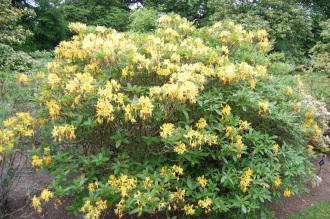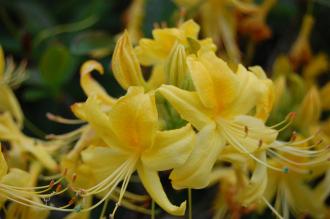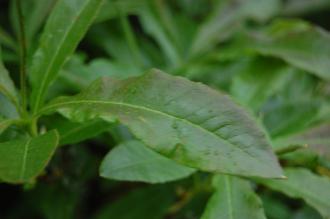
Rhododendron luteum (23/05/2015, Kew Gardens, London)
Position: Full sun to partial shade
Flowering period: Spring
Soil: Moist, well drained, acidic
Eventual Height: 3m
Eventual Spread: 4m
Hardiness: 4b, 5a, 5b, 6a, 6b, 7a, 7b, 8a, 8b
Family: Ericaceae
Rhododendron luteum is a deciduous shrub with an open bushy habit. Its dark leathery green leaves are elliptic with entire margins, up to 10cm in long and 4cm broad. Its leaves turn orange/ red in autumn before they fall. Its fragrant yellow flowers are funnel shaped with wavy edges, up to 4cm across and appear in groups of up to 25. The fruit of the plant is dry capsule and up to 25mm long.

Rhododendron luteum Flower (23/05/2015, Kew Gardens, London)
Rhododendron luteum, commonly known as Yellow Azalea, Honeysuckle Azalea or Sweet Pontica Azalea, is native to southeast Europe and southwest Asia. It has become naturalised in parts of the UK.
The etymological root of the binomial name Rhododendron is derived from the Greek rodon ‘a rose’ and dendron ‘a tree’. Luteum is from the Latin meaning ‘yellow’.
The landscape architect may find Rhododendron luteum useful as an attractive spring flowering shrub suitable for planting in soils with an acid pH.

Rhododendron luteum Leaf (23/05/2015, Kew Gardens, London)
Ecologically, Rhododendron luteum flowers are attractive to pollinating insects. Its flowers produce a toxic nectar which, when collected by bees, produce a poisonious honey.
The Royal Horticultural Society has given the variety Rhododendron luteum their prestigious Award of Garden Merit in 1993.
Rhododendron luteum prefers moist, humus rich, well-drained soils. It prefers an acid pH of soil.
Rhododendron luteum requires little maintenance. Any necessary pruning should be carried out in late winter to early spring.

Landscape Architecture

